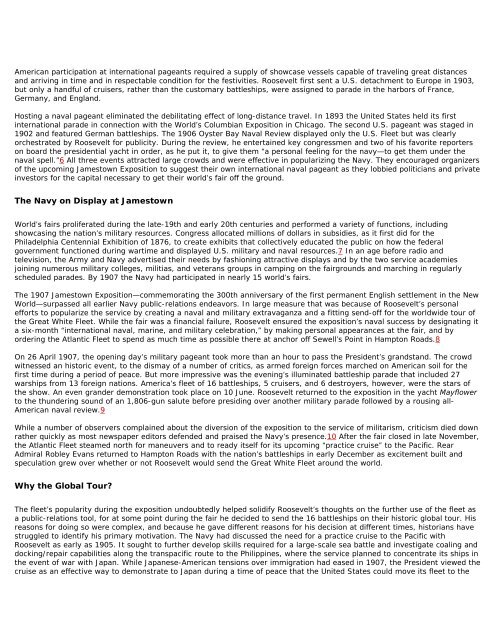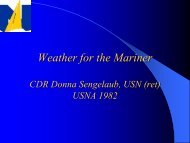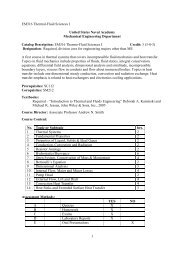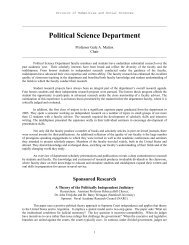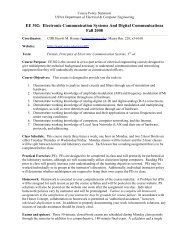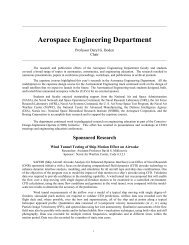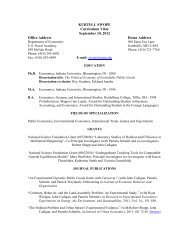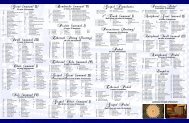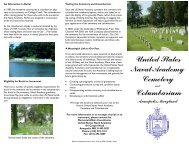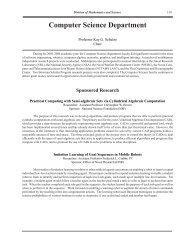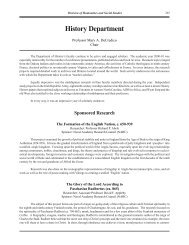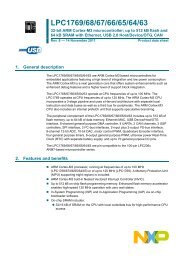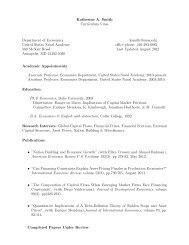Naval History Magazine - United States Naval Academy
Naval History Magazine - United States Naval Academy
Naval History Magazine - United States Naval Academy
Create successful ePaper yourself
Turn your PDF publications into a flip-book with our unique Google optimized e-Paper software.
American participation at international pageants required a supply of showcase vessels capable of traveling great distancesand arriving in time and in respectable condition for the festivities. Roosevelt first sent a U.S. detachment to Europe in 1903,but only a handful of cruisers, rather than the customary battleships, were assigned to parade in the harbors of France,Germany, and England.Hosting a naval pageant eliminated the debilitating effect of long-distance travel. In 1893 the <strong>United</strong> <strong>States</strong> held its firstinternational parade in connection with the World’s Columbian Exposition in Chicago. The second U.S. pageant was staged in1902 and featured German battleships. The 1906 Oyster Bay <strong>Naval</strong> Review displayed only the U.S. Fleet but was clearlyorchestrated by Roosevelt for publicity. During the review, he entertained key congressmen and two of his favorite reporterson board the presidential yacht in order, as he put it, to give them “a personal feeling for the navy—to get them under thenaval spell.”6 All three events attracted large crowds and were effective in popularizing the Navy. They encouraged organizersof the upcoming Jamestown Exposition to suggest their own international naval pageant as they lobbied politicians and privateinvestors for the capital necessary to get their world’s fair off the ground.The Navy on Display at JamestownWorld’s fairs proliferated during the late-19th and early 20th centuries and performed a variety of functions, includingshowcasing the nation’s military resources. Congress allocated millions of dollars in subsidies, as it first did for thePhiladelphia Centennial Exhibition of 1876, to create exhibits that collectively educated the public on how the federalgovernment functioned during wartime and displayed U.S. military and naval resources.7 In an age before radio andtelevision, the Army and Navy advertised their needs by fashioning attractive displays and by the two service academiesjoining numerous military colleges, militias, and veterans groups in camping on the fairgrounds and marching in regularlyscheduled parades. By 1907 the Navy had participated in nearly 15 world’s fairs.The 1907 Jamestown Exposition—commemorating the 300th anniversary of the first permanent English settlement in the NewWorld—surpassed all earlier Navy public-relations endeavors. In large measure that was because of Roosevelt’s personalefforts to popularize the service by creating a naval and military extravaganza and a fitting send-off for the worldwide tour ofthe Great White Fleet. While the fair was a financial failure, Roosevelt ensured the exposition’s naval success by designating ita six-month “international naval, marine, and military celebration,” by making personal appearances at the fair, and byordering the Atlantic Fleet to spend as much time as possible there at anchor off Sewell’s Point in Hampton Roads.8On 26 April 1907, the opening day’s military pageant took more than an hour to pass the President’s grandstand. The crowdwitnessed an historic event, to the dismay of a number of critics, as armed foreign forces marched on American soil for thefirst time during a period of peace. But more impressive was the evening’s illuminated battleship parade that included 27warships from 13 foreign nations. America’s fleet of 16 battleships, 5 cruisers, and 6 destroyers, however, were the stars ofthe show. An even grander demonstration took place on 10 June. Roosevelt returned to the exposition in the yacht Mayflowerto the thundering sound of an 1,806-gun salute before presiding over another military parade followed by a rousing all-American naval review.9While a number of observers complained about the diversion of the exposition to the service of militarism, criticism died downrather quickly as most newspaper editors defended and praised the Navy’s presence.10 After the fair closed in late November,the Atlantic Fleet steamed north for maneuvers and to ready itself for its upcoming “practice cruise” to the Pacific. RearAdmiral Robley Evans returned to Hampton Roads with the nation’s battleships in early December as excitement built andspeculation grew over whether or not Roosevelt would send the Great White Fleet around the world.Why the Global Tour?The fleet’s popularity during the exposition undoubtedly helped solidify Roosevelt’s thoughts on the further use of the fleet asa public-relations tool, for at some point during the fair he decided to send the 16 battleships on their historic global tour. Hisreasons for doing so were complex, and because he gave different reasons for his decision at different times, historians havestruggled to identify his primary motivation. The Navy had discussed the need for a practice cruise to the Pacific withRoosevelt as early as 1905. It sought to further develop skills required for a large-scale sea battle and investigate coaling anddocking/repair capabilities along the transpacific route to the Philippines, where the service planned to concentrate its ships inthe event of war with Japan. While Japanese-American tensions over immigration had eased in 1907, the President viewed thecruise as an effective way to demonstrate to Japan during a time of peace that the <strong>United</strong> <strong>States</strong> could move its fleet to the


